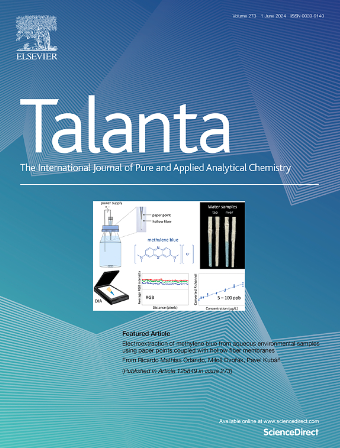小型化傅立叶反褶积离子迁移谱仪精确检测痕量黑火药
IF 5.6
1区 化学
Q1 CHEMISTRY, ANALYTICAL
引用次数: 0
摘要
黑火药(BP)是一种低爆炸性混合物,由硫磺、硝酸钾和木炭混合而成,由于其易燃性和潜在的非法活动用途而构成重大风险。准确检测黑火药(BP)对公共安全、安保和法规遵从性至关重要。然而,当使用小型离子迁移谱仪时,由于硫离子峰与反应物离子(O2−(H2O)n)的峰严重重叠,因此BP的检测具有挑战性。本研究提出了一种简便、准确、灵敏的BP检测方法,利用小型化的傅立叶反卷积离子迁移谱仪(FD-IMS),直接提高了O2−(H2O)n峰和硫离子峰的分辨率,而无需添加任何氯化烃改性剂,避免了传统方法中改性剂带来的复杂性和污染风险。该装置在漂移区电压为1.54 kV、长度为42.5 mm时,在优化的检测温度和漂移气体湿度下,O2−(H2O)n和S3−离子峰之间的分辨率高达2.07,硫的最低检测质量小于0.1 ng。实验证明,该微型化FD-IMS能够检测微量BP小于1 ng,也能检测其他含氮有机炸药。本文章由计算机程序翻译,如有差异,请以英文原文为准。

Accurate detection of trace level black powder with miniaturized Fourier deconvolution ion mobility spectrometer
Black powder (BP), a low-explosive mixture, is created by mixing sulfur, potassium nitrate, and charcoal, poses significant risks due to its flammability and potential use in illicit activities. Accurate detection of black powder (BP) is crucial for public safety, security, and regulatory compliance. However, the detection of BP is challenging when using miniaturized ion mobility spectrometers because of the sulfur ion peak overlaps heavily with that of the reactant ions (). A simple method is proposed in this study for accurate and sensitive detection of BP, utilizing a miniaturized Fourier deconvolution ion mobility spectrometer (FD-IMS), which directly improves the resolution between the peak and the sulfur ion peak without the need to add any chlorinated hydrocarbon modifiers, and avoids the complexities and contamination risks posed by modifiers in the conventional method. The demonstrated device achieved a resolution of up to 2.07 between the and ion peaks at a drift region voltage and length of 1.54 kV and 42.5 mm, under optimized detection temperature and drift gas humidity, with a minimum detectable quality of sulfur of less than 0.1 ng. It was proven that this miniaturized FD-IMS is qualified to detect trace level BP less than 1 ng as well as other nitro-organic explosives.
求助全文
通过发布文献求助,成功后即可免费获取论文全文。
去求助
来源期刊

Talanta
化学-分析化学
CiteScore
12.30
自引率
4.90%
发文量
861
审稿时长
29 days
期刊介绍:
Talanta provides a forum for the publication of original research papers, short communications, and critical reviews in all branches of pure and applied analytical chemistry. Papers are evaluated based on established guidelines, including the fundamental nature of the study, scientific novelty, substantial improvement or advantage over existing technology or methods, and demonstrated analytical applicability. Original research papers on fundamental studies, and on novel sensor and instrumentation developments, are encouraged. Novel or improved applications in areas such as clinical and biological chemistry, environmental analysis, geochemistry, materials science and engineering, and analytical platforms for omics development are welcome.
Analytical performance of methods should be determined, including interference and matrix effects, and methods should be validated by comparison with a standard method, or analysis of a certified reference material. Simple spiking recoveries may not be sufficient. The developed method should especially comprise information on selectivity, sensitivity, detection limits, accuracy, and reliability. However, applying official validation or robustness studies to a routine method or technique does not necessarily constitute novelty. Proper statistical treatment of the data should be provided. Relevant literature should be cited, including related publications by the authors, and authors should discuss how their proposed methodology compares with previously reported methods.
 求助内容:
求助内容: 应助结果提醒方式:
应助结果提醒方式:


